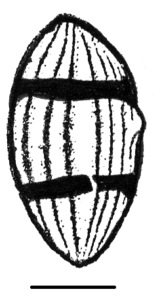Fungalpedia – Note 240, Kumarisporites (Fossil Fungi)
Kumarisporites Kalgutkar & Janson.
Citation when using this entry: Saxena RK & Hyde KD. 2024 (in prep) – Fungalpedia, Fossil Fungi
Index Fungorum, Facesoffungi, MycoBank, GenBank, Fig. 1
Classification: Fossil Ascomycota, Incertae sedis, Fungi
The monotypic fossil genus, Kumarisporites, was instituted by Kalgutkar & Jansonius (2000) to accommodate Imprimospora ramanujamii, originally described by Kumar (1990), from the Quilon Beds (Early-Middle Miocene, 23–12 mya) of clay mine section near Kanjantheria House, Padappakkara, Kollam District, Kerala, India. The genus includes small to medium-sized (32–40 × 18–21 μm), tricellate, inaperturate and fusiform fungal spores. Central cell (11–13 × 16–19 μm) may be larger than the tapering terminal cells (9–10 μm long) which have narrowly rounded ends. The septa (or septal bases) thicker (1.6–2 μm thick) than spore wall, with or without a central pore. The spore wall (± 1.5 μm thick) ornamented by longitudinal ribs (about 2 μm wide), running full length of the spore, tapering towards the poles. Furrows 1–2 μm wide.
Homotypic Synonym: Imprimospora ramanujamii P. Kumar 1990.
Type species: Kumarisporites ramanujamii (P. Kumar) Kalgutkar & Janson. 2000.
Figure 1 – Kumarisporites ramanujamii. Scale bar = 10 μm. Redrawn from Kumar (1990).
References
Entry by
Ramesh K. Saxena, Birbal Sahni Institute of Palaeosciences, Lucknow, India
(Edited by Kevin D. Hyde, Samaneh Chaharmiri-Dokhaharani, & Achala R. Rathnayaka)
Published online 22 April 2024
